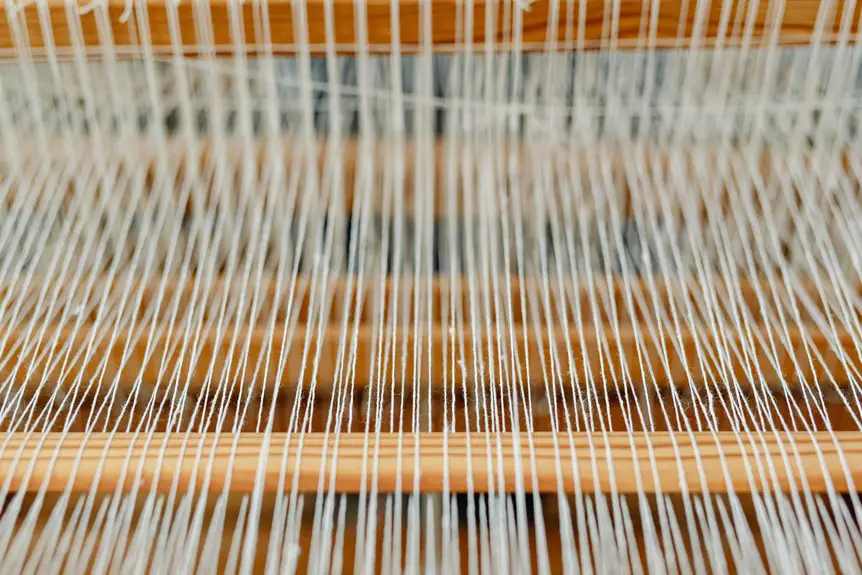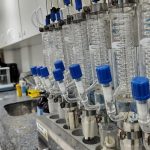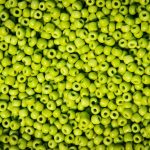Polyamide yarn is made from raw materials like hexamethylenediamine and adipic acid or caprolactam, which undergo polymerization to form long chains called polymers. During manufacturing, these polymers are melted and spun through spinnerets to create strong, flexible fibers. The yarn is then drawn and sometimes texturized to enhance durability and stretch. You’ll also find quality checks ensuring strength, moisture resistance, and color consistency. Keep exploring and you’ll uncover more details about this versatile yarn’s production.
Table of Contents
Key Takeaways
- Polyamide yarn is made from repeating molecular units linked by amide bonds, commonly Nylon 6 or Nylon 6,6 variants.
- Raw materials include diamines and dicarboxylic acids, such as hexamethylenediamine and adipic acid for Nylon 6,6, or caprolactam for Nylon 6.
- Polymerization forms long polymer chains through condensation reactions, releasing by-products like water, influencing yarn strength and flexibility.
- Melt spinning melts the polymer and extrudes it through spinnerets to create filaments; solution spinning is less common for polyamide.
- Yarn quality is ensured by monitoring fiber diameter, strength, elongation, moisture content, and dye uptake during and after production.
Overview of Polyamide Fibers
Although you mightn’t realize it, polyamide fibers play an essential role in many everyday products. When you wear sportswear or use a durable backpack, you’re relying on polyamide’s strength and flexibility.
These fibers are known for their excellent elasticity, abrasion resistance, and lightweight nature, making them ideal for textiles that need to withstand stress and frequent use. You’ll find polyamide fibers in clothing, upholstery, and even industrial applications like ropes and fishing lines.
Polyamide fibers offer elasticity, abrasion resistance, and lightness, perfect for durable clothing and industrial uses.
Their ability to dry quickly and resist wrinkles adds to their practical appeal. By understanding what polyamide fibers offer, you get a clearer picture of why manufacturers choose them so often.
They combine durability with comfort, ensuring that the products you use daily don’t just look good but last long, too.
Chemical Composition of Polyamide Yarn
You’ll find that polyamide yarn is built from repeating molecular units linked by amide bonds, giving it strength and flexibility.
The most common variants you’ll encounter are Nylon 6 and Nylon 6,6, each with distinct properties based on their chemical structure.
Understanding these differences helps you grasp how the yarn performs in various applications.
Molecular Structure Overview
Understanding the molecular structure of polyamide yarn helps you appreciate how its chemical composition influences its strength and flexibility.
Polyamides consist of repeating units linked by amide bonds (-CONH-), forming long, linear chains. These chains align closely, creating strong intermolecular hydrogen bonds that provide durability and resilience.
The arrangement of these molecules allows for both rigidity and elasticity, which is why polyamide yarn performs well under stress without breaking.
You’ll find that the regularity and length of these chains affect melting points and moisture absorption, contributing to the yarn’s overall performance.
Common Polyamide Variants
Since polyamide yarns come in various forms, knowing their common variants helps you choose the right type for your needs.
The two main types you’ll encounter are Nylon 6 and Nylon 6,6. Nylon 6 is made from a single monomer, caprolactam, while Nylon 6,6 is produced from two monomers, hexamethylene diamine and adipic acid.
This difference affects their melting points, strength, and elasticity. Nylon 6,6 generally offers higher heat resistance and tensile strength, making it suitable for demanding applications.
On the other hand, Nylon 6 provides better elasticity and dye affinity, ideal for apparel and textiles.
Understanding these variants enables you to pick polyamide yarns that balance durability, flexibility, and processing ease according to your project’s requirements.
Raw Materials Used in Polyamide Production
The foundation of polyamide production lies in selecting the right raw materials, which primarily include diamines and dicarboxylic acids.
You’ll find that hexamethylenediamine and adipic acid are commonly used to create nylon 6,6, a popular polyamide variant. For nylon 6, the raw material is caprolactam, a cyclic amide.
These chemical building blocks determine the properties of the final polyamide yarn, such as strength, elasticity, and moisture resistance.
Besides these core components, additives like stabilizers and pigments may be included to enhance performance or appearance.
However, the purity and quality of the diamines and acids are essential since impurities can affect the polymer’s consistency.
Polymerization Process for Polyamide
To start the polymerization process for polyamide, you first choose the right monomers based on the desired properties.
Then, you initiate a chemical reaction that links these monomers into long polymer chains.
This step is essential because the chain formation directly affects the strength and flexibility of the final yarn.
Monomer Selection
Although choosing the right monomers might seem straightforward, it plays an important role in determining the properties of the final polyamide yarn. You’ll typically select diamines and dicarboxylic acids or lactams as your monomers.
For example, nylon 6,6 comes from hexamethylenediamine and adipic acid, while nylon 6 is made from caprolactam. Each monomer combination influences characteristics like strength, elasticity, moisture absorption, and melting point.
You must also consider purity since impurities can affect polymer quality. By carefully selecting monomers, you tailor the yarn’s performance to specific applications, whether for durable textiles or elastic fibers.
This vital step guarantees your polyamide yarn meets the desired standards before the polymer chains start forming in the next phase.
Polymer Chain Formation
Once you’ve selected high-quality monomers, you’ll initiate the polymerization process to form long polyamide chains. This involves linking monomers through condensation reactions, where molecules combine and release small by-products like water. The result is a strong, flexible polymer chain essential for durable yarn.
Here’s a quick look at key steps in polymer chain formation:
| Step | Description |
|---|---|
| Monomer Activation | Monomers prepare for bonding |
| Chain Initiation | First bond forms between monomers |
| Chain Propagation | Additional monomers link sequentially |
| Chain Termination | Polymer chain length finalizes |
Spinning Techniques in Yarn Manufacturing
Spinning techniques form the backbone of yarn manufacturing, directly influencing the strength, texture, and appearance of polyamide yarns.
Spinning methods are essential in shaping the strength, texture, and look of polyamide yarns.
When you spin polyamide fibers, you transform the polymer chips into continuous filaments. The two main methods you’ll encounter are melt spinning and solution spinning.
Melt spinning involves melting the polyamide polymer and extruding it through spinnerets to form filaments, which then solidify as they cool.
Solution spinning, less common for polyamide, dissolves the polymer before extrusion.
You control filament thickness, strength, and uniformity by adjusting spinning speed and temperature. Additionally, you can produce either monofilament or multifilament yarns depending on the spinneret design.
Drawing and Texturizing Polyamide Fibers
Two essential steps that follow spinning in polyamide yarn manufacturing are drawing and texturizing, which enhance the fiber’s physical properties and versatility.
When you draw polyamide fibers, you stretch them to align the molecules, boosting strength and elasticity.
Texturizing, on the other hand, adds bulk and texture, making the yarn softer and more breathable.
Here’s what you should know about these processes:
- Drawing increases tensile strength and uniformity
- Texturizing introduces crimps for stretch and insulation
- Both steps improve dye absorption and fabric appearance
- Texturized fibers feel more natural and comfortable
- These processes tailor yarn for diverse applications like activewear and upholstery
Quality Control and Testing Procedures
Although drawing and texturizing enhance polyamide fibers, maintaining consistent quality requires rigorous control and testing.
You’ll start by inspecting raw materials for purity and uniformity, guaranteeing no contaminants affect the final yarn. Throughout production, you’ll monitor fiber diameter, strength, and elongation using specialized instruments.
Regular sampling allows you to detect any deviations early, so you can adjust processing parameters promptly. Additionally, moisture content and dye uptake tests help verify the yarn performs as expected in various conditions.
Finally, you’ll conduct tensile and abrasion resistance tests on finished yarns to confirm durability and reliability. By following these procedures diligently, you assure that the polyamide yarn meets industry standards and customer expectations every time.
Applications and Benefits of Polyamide Yarn
Polyamide yarn offers exceptional strength, flexibility, and resistance, making it a popular choice across various industries.
When you use polyamide yarn, you benefit from its durability and lightweight nature, which enhances product performance and longevity.
It excels in environments where abrasion and moisture resistance are essential, ensuring your items stay reliable and functional.
Here are some key applications and benefits you’ll appreciate:
- Sportswear and activewear for comfort and stretch
- Industrial textiles that require toughness and durability
- Upholstery and home furnishings for enhanced wear resistance
- Fishing nets and ropes benefiting from moisture resistance
- Automotive components demanding strength and flexibility
Frequently Asked Questions
How Does Polyamide Yarn Compare to Natural Fibers in Sustainability?
You’ll find polyamide yarn less sustainable than natural fibers since it relies on petroleum, uses more energy, and takes longer to decompose. However, it’s durable and recyclable, so you can reduce impact by choosing recycled polyamide options.
Can Polyamide Yarn Be Recycled After Use?
Don’t throw the baby out with the bathwater—yes, you can recycle polyamide yarn! Though it takes specialized processes, recycling helps you reduce waste and gives this synthetic fiber a second chance in new products.
What Environmental Impacts Are Associated With Polyamide Production?
You’ll find polyamide production uses significant energy and releases greenhouse gases. It also depends on non-renewable resources and can cause water pollution. Reducing impact means choosing recycled options or sustainable alternatives whenever you can.
How Does Polyamide Yarn Perform in Extreme Weather Conditions?
You might think polyamide yarn struggles in extreme weather, but it actually excels. It resists moisture, dries quickly, and maintains strength in cold or heat, making it reliable for harsh conditions you’ll face outdoors.
Are There Any Health Concerns When Handling Polyamide Fibers?
You don’t need to worry much when handling polyamide fibers; they’re generally safe. However, avoid inhaling dust or fumes during manufacturing, and wearing protective gear is a smart move to prevent skin irritation or respiratory issues.
- Does Chiffon Fabric Stink - July 15, 2025
- Does Chiffon Fabric Affect the Economy - July 15, 2025
- Does Cotton Fabric Have a Nap - July 15, 2025







